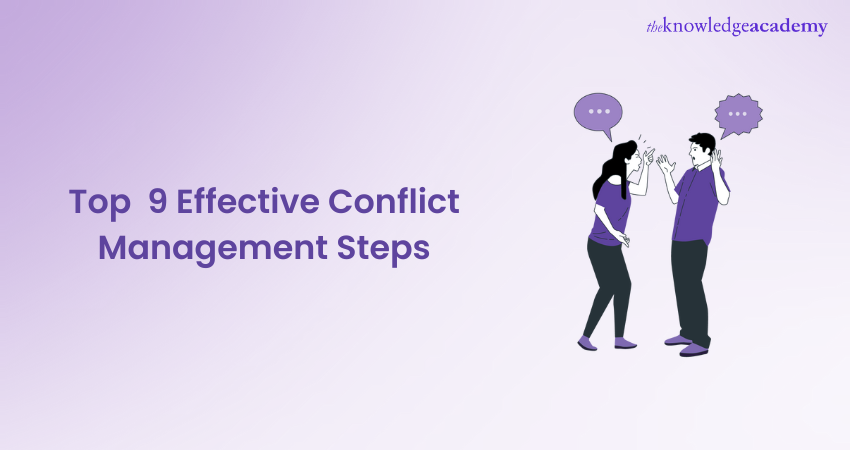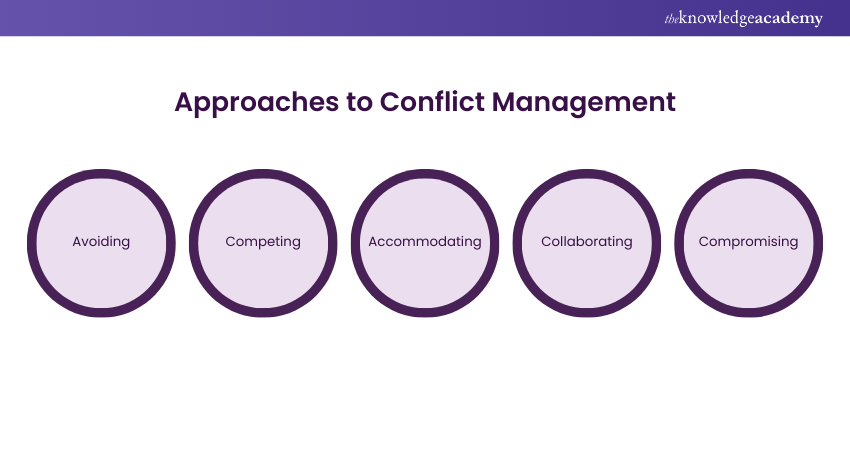We may not have the course you’re looking for. If you enquire or give us a call on 01344203999 and speak to our training experts, we may still be able to help with your training requirements.
We ensure quality, budget-alignment, and timely delivery by our expert instructors.

Conflicts can arise from anywhere if you are working in a business environment. These disputes can hamper a business’s reputation, productivity and results. That is why understanding Conflict Management Steps becomes crucial for organizations.
Today, conflicts arise across businesses more often than ever. According to the Myers Briggs research, out of the people surveyed, 36% of them reported that they deal with conflict often, very often, or all the time. But it’s high time that we address the issue.
Don’t know how to resolve conflicts? Worry no more. Read this blog to learn about implementing Conflict Management Steps in the workplace. Also, explore how to resolve disputes to maintain and improve productivity.
Table of Contents
1) Steps of Conflict Management
a) Step 1: Define the source of the conflict
b) Step 2: Be alert
c) Step 3: Take a proactive approach
d) Step 4: Be empathetic
e) Step 5: Communicate
f) Step 6: Ask for help
g) Step 7: Look for effective Conflict Management Strategies
h) Step 8: Act
i) Step 9: Reflect
2) Conclusion
Steps of Conflict Management
Conflicts are integral to any workplace. They can manifest in any form due to internal and external factors. However, when these issues start to occur more often, they can become subject to ponder. They can hamper business productivity and can have heavy repercussions on its reputation.
So, avoiding and eliminating these issues is important for businesses to save themselves from any downfall. But what are the steps in managing conflicts? Let’s find out the steps to effective Conflict Management as mentioned below:
Step 1: Define the source of the conflict
Having more information on the root cause of the problem is the key to successfully solve it. Resolution Strategies could be as below to get the information, you need in that respect. As a manager or supervisor, you need to get the chance to all parties including the parties to lay their side of the story. It helps you in grasping the things right; the problem will get clearer if you have enough information.
Step 2: Be alert
Conflicts can arise at any point in time. Staying alert about the situation at hand and approaching it as a normal occurrence can prevent employees from getting into trouble. Further, being alert of the issue as soon as it occurs can help turn potential disagreements into clearly communicated discussions and improve processes.
Step 3: Take a proactive approach
By early intervention and prevention, most issues can be resolved. As soon as any issue or dispute arises, take the matter in hand, listen to the side of each party and reflect on the whole situation. Remember, don’t let the issue become a conflict; address it proactively and efficiently.
Step 4: Be empathetic
One of the most important Conflict Management Steps is being empathetic. Do not try to give your opinion about the issue. Instead, understand what the conflict is about and its impact on the parties involved. Further, reflect on what it can mean to an organisation. As you try to put yourself in others’ shoes, you will be able to understand better what is at stake. Being empathetic will also help you resolve it more effectively.
Step 5: Communicate
After listening to all sides of the argument, initiate communication and ask questions to the parties involved. Asking questions will help you gain a deep understanding of the root cause. While initiating communication between them will eliminate any chances of conflict occurring soon.
Step 6: Ask for help
Ask for a neutral third party to assist you in building a clear communication channel and prevent any further conflict escalation. To get unbiased responses and uncover issues that require greater attention, consult others. For example, you can ask a Conflict Management Practitioner for assistance.
Learn how to employ strong management skills with our Management Courses.
Step 7: Look for effective Conflict Management Strategies
There are various Conflict Management skills and Strategies that you can opt for to resolve issues. Therefore, it’s better to adopt the right strategy for better resolution. The various strategies include the following:

1) Avoiding:
This method involves pretending that there is no conflict or avoiding it altogether. People who use this method do not want to engage in the conflict. It is because they are afraid of the consequences, they do not care about the outcome, or they do not think it is worth their time and energy.
However, avoiding can be a useful strategy in some situations, such as when the conflict is trivial or when one party needs time to calm down before addressing the issue. At the same time, avoiding it can also have negative consequences, such as creating more problems and tensions as the conflict remains unresolved.
2) Competing:
This method is aggressive and assertive, and it involves trying to win the conflict at any cost. It is also known as a win-lose Conflict Resolution strategy. This method does not lead to satisfactory outcomes, as it does not allow for cooperation and problem-solving.
People who use this method may damage their relationships with others, as they may appear arrogant, selfish, or hostile. Although, competing can be appropriate in some situations, such as when there is an emergency or when decisive action is needed.
3) Accommodating:
This method, also known as smoothing, involves giving in to the other party and satisfying their needs. This method can resolve the conflict quickly and maintain the relationship. However, it can also result in resentment and loss of self-esteem for the accommodating party, as they may feel that their needs and opinions are not valued. Accommodating can be appropriate in some situations, such as when the issue is more important to the other party, when the accommodating party is wrong, or when harmony is essential.
4) Collaborating:
This method, like the compromising method, involves working with the other party to find a solution that meets both parties’ needs. It is also known as a win-win strategy. For example, a salesperson and a client may negotiate the terms of a contract until they both agree. This method can lead to creative and effective solutions, as well as mutual respect and trust.
However, it can also be time-consuming and complex, as it requires a high level of communication and cooperation. It is appropriate in some situations, such as when the issue is complex, when both parties have strong interests, or when a long-term relationship is important.
5) Compromising:
This method, also known as reconciling. It involves finding a common ground that both parties can accept. It is also known as a lose-lose strategy, as both parties have to give up something. This method can be a quick and practical way to resolve a conflict, especially when time is limited or when the parties have equal power.
However, it can also result in suboptimal solutions and dissatisfaction for both parties, as they may feel that they have not achieved their goals. Compromising can be appropriate in some situations, such as when there is no clear solution, or when a temporary solution is needed.
Additionally, it’s better to reach out to a Conflict Management Practitioner who can help you adopt the right Conflict Management Measures. This will help you decide the best way to manage the issue.
Step 8: Act
After assessing your options and understanding the situation, use your knowledge and resources to take the right action. To take the “right” action, you can build and enhance various Conflict Management Skills. These skills include conflict coaching, gaining skills to handle difficult people and preparing for discussions.
Step 9: Reflect
Regardless of whether the conflict is resolved, further, reflect on the situation. It means learning from the situation and asking yourself how it has impacted the business operations and what you can change to prevent similar situations in the future.
Gain skills to promote teamwork and motivate employees with our Personal & Organisational Development Course.
Glasers’ three-step strategy for conflict resolution
Renowned Conflict Management consultants Peter and Susan Glaser recommended a three-step strategy to resolve conflict. Their suggested steps are as follows:
a) Prove that you understand their style: This step emphasises the importance of actively listening and empathising with the other person's perspective. By demonstrating that you understand their communication style, preferences, and concerns, you respect their openness to finding a mutually acceptable solution.
b) Acknowledge that you are a part of the problem: Acknowledging your role in the conflict is essential for constructive resolution. It involves taking accountability for your actions, behaviours, or contributions to the conflict. By acknowledging your part in the problem, you demonstrate humility and willingness to work towards a resolution collaboratively.
c) Try again if the conversation didn’t go well: This step highlights the importance of persistence and resilience in conflict resolution. If the initial conversation or attempt to resolve the conflict doesn't yield positive results, it's essential to remain patient and open to revisiting the discussion. By trying again, you demonstrate commitment to finding a resolution and fostering positive communication.
Conclusion
Managing conflict is a vital skill that enables individuals and organisations to navigate disagreements and tensions effectively. By following the Conflict Management Steps, you can resolve conflicts constructively.
Elevate your team's performance and drive success with our comprehensive Performance Management Training – join us now!
Frequently Asked Questions

The 6 Cs of Conflict Management are as follows:
a) Communication
b) Collaboration
c) Compromise
d) Control
e) Civility
f) Commitment
These are strategies that can help people deal with conflicts in a constructive way.

The primary conflict types include interpersonal, intragroup, and intergroup. Interpersonal conflict arises among individuals with differing personalities, goals, or values. Intragroup conflict occurs within a group with varying opinions, interests, or roles. Intergroup conflict arises between groups with competing objectives, resources, or values.

The Knowledge Academy takes global learning to new heights, offering over 30,000 online courses across 490+ locations in 220 countries. This expansive reach ensures accessibility and convenience for learners worldwide.
Alongside our diverse Online Course Catalogue, encompassing 17 major categories, we go the extra mile by providing a plethora of free educational Online Resources like News updates, blogs, videos, webinars, and interview questions. By tailoring learning experiences further, professionals can maximise value with customisable Course Bundles of TKA.

The Knowledge Academy offers various Management Courses, including Conflict Management Training, Team Development Masterclass, Introduction to Management and many more. These courses cater to different skill levels, providing comprehensive insights into Management methodologies in general.
Our Business Skills Blogs cover a range of topics related to Management, offering valuable resources, best practices, and industry insights. Whether you are a beginner or looking to advance your Management skills, The Knowledge Academy's diverse courses and informative blogs have you covered.

The Knowledge Academy’s Knowledge Pass, a prepaid voucher, adds another layer of flexibility, allowing course bookings over a 12-month period. Join us on a journey where education knows no bounds.
Upcoming Business Skills Resources Batches & Dates
Date
 Conflict Management Training
Conflict Management Training
Fri 14th Feb 2025
Fri 11th Apr 2025
Fri 13th Jun 2025
Fri 15th Aug 2025
Fri 10th Oct 2025
Fri 12th Dec 2025







 Top Rated Course
Top Rated Course



 If you wish to make any changes to your course, please
If you wish to make any changes to your course, please


